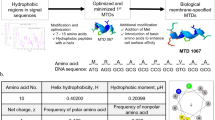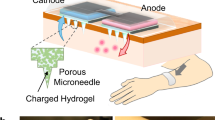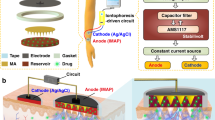Abstract
Transdermal administration by iontophoresis (enhanced transport via the skin using the driving force of an applied electric field) has been successfully demonstrated but no formal relationship between peptide sequence/structure and efficiency of delivery has been established. There are notable examples, such as the lipophilic leutinizing hormone releasing hormone (LHRH) analogs, Nafarelin and Leuprolide, that exhibit down-regulation of their own transport across the skin under the influence of an iontophoretic current. The hypothesis that this phenomenon is due to neutralization of the skin's net negative charge by these cationic peptides was examined with LHRH oligopeptides. The impact of these compounds on the electroosmotic flow of solvent into the skin, which is induced by iontophoresis and which contributes significantly to the electrotransport of large, positively charged ions, was examined and quantified. Close juxtaposition of cationic and lipophilic residues profoundly inhibited electroosmosis and, presumably, peptide flux. The results indicate that the lipophilicity of the oligopeptides facilitates van der Waals interactions with hydrophobic patches along the transport route, thereby permitting the positively charged oligopeptide to interact with carboxylate side chains that give the skin its net negative charge at neutral pH. The lipophilic, cationic oligopeptide, therefore, becomes anchored in the transport path, neutralizing the original charge of the membrane, and completely altering the permselective properties of the skin.
This is a preview of subscription content, access via your institution
Access options
Subscribe to this journal
Receive 12 print issues and online access
$209.00 per year
only $17.42 per issue
Buy this article
- Purchase on Springer Link
- Instant access to full article PDF
Prices may be subject to local taxes which are calculated during checkout
Similar content being viewed by others
References
Tachibana, K. 1992. Transdermal delivery of insulin to alloxan-diabetic rabbits by ultrasound exposure. Pharm. Res. 9: 952–954.
Mitragotri, S., Blankschtein, D., and Langer, R. 1995. Ultrasound-mediated transdermal protein delivery. Science 269: 850–853.
Rao, G., Glikfeld, P., and Guy, R.H. 1993. Reverse iontophoresis: development of a noninvasive approach for glucose monitoring. Pharm. Res. 10: 1751–1755.
Rao, G., Guy, R.H., Glikfeld, P., LaCourse, W.R., Leung, L., Tamada, J. et al. 1995. Reverse iontophoresis: noninvasive glucose montioring in vivo in humans. Pharm. Res. 12: 1869–1873.
Tamada, J.A., Bohannon, N.J.V., and Potts, R.O. 1995. Measurement of glucose in diabetic subjects using noninvasive transdermal extraction. Nature Med. 1: 1198–1201.
Guy, R.H. 1995. A sweeter life for diabetics? Nature Med. 1: 1132–1133.
Pikal, M.J. 1992. The role of electroosmotic flow in transdermal iontophoresis. Adv. Drug Deliv. Rev. 9: 201–237.
Green, P.G., Hinz, R.S., Cullander, C., Yamane, G., and Guy, R.H. 1991. Iontophoretic delivery of amino acids and amino acid derivatives across the skin in vitro. Pharm. Res. 8: 1113–1120.
Delgado-Charro, M.B. and Guy, R.H. 1995. Iontophoretic delivery of Nafarelin across the skin. Int. J. Pharm. 117: 165–172.
Delgado-Charro, M.B. and Guy, R.H. 1996. Iontophoresis of peptides, in Electronically Controlled Drug Delivery. Berner, B. and Dinh, S. (eds.). CRC Press, Boca Raton, FL In press.
Amsden, B.G. and Goosen, M.F.A. 1995. Transdermal delivery of peptide and protein drugs: an overview. AlChE J. 41: 1972–1997.
Yoshida, N.H. and Roberts, M.S. 1992. Structure-transport relationships in transdermal iontophoresis. Adv. Drug. Deliv. Rev. 9: 239–264.
Delgado-Charro, M.B. and Guy, R.H. 1994. Characterization of convective solvent flow during iontophoresis. Pharm. Res. 11: 929–935.
Delgado-Charro, M.B., Rodríguez-Bayón, A.M., and Guy, R.H. 1995. Iontophoresis of Nafarelin: effects of current density and concentration on electro-transport in vitro. J. Control. Rel. 35: 35–40.
Hoogstraate, A.J., Srinivasan, V., Simms, S.M., and Higuchi, W.I. 1994. Iontophoretic enhancement of peptides: behavior of leuprolide versus model permeants. J. Control. Rel. 31: 41–47.
Lau, D.T.-W., Sharkey, J.W., Petryk, L., Mancuso, F.A., Yu Z., and Tse, F.L.S. 1994. Effect of current magnitude and drug concentration on iontophoretic delivery of octreotide acetate (Sandostatin®) in the rabbit. Pharm. Res. 11: 1742–1746.
Burnette, R.R. 1989. Iontophoresis, pp. 247–291 in Drugs and the Pharmaceutical Sciences: Volume 35: Transdermal Drug Delivery: Developmental Issues and Research Initiatives. Hadgraft, J. and Guy, R.H. (eds.). Marcel Dekker, New York.
Burnette, R.R. and Ongpipattanakul, B. 1988. Characterization of the pore transport properties and tissue alteration of excised human skin during iontophoresis. J. Pharm. Sci. 77: 132–137.
Cullander, C. and Guy, R.H. 1991. Sites of iontophoretic current flow into the skin: identification and characterization with the vibrating probe electrode. J. Invest. Dermatol. 97: 55–64.
Turner, N., Ferry, L., Cullander, C., and Guy, R.H. 1994. Iontophoresis of poly-L-lysines: Transport as a function of molecular weight measured by confocal microscopy. Proceed. Intern. Symp. Control. Rel. Bioact. Mater. 21: 393–394.
Craane-van Hinsberg, W.H.M., Verhoef, J.C., Bax, L.J., Junginger, H.E., and Boddé, H.E. 1995. Role of appendages in skin resistance and iontophoretic peptide flux: human versus snake skin. Pharm. Res. 12: 1506–1512.
Downing, D.T. 1991. Lipid and protein structures in the permeability barrier of mammalian epidermis. J. Lipid Res. 33: 301–313.
Glikfeld, P., Cullander, C., Hinz, R.S., and Guy, R.H. 1988. A new system for in vitro studies of iontophoresis. Pharm. Res. 5: 443–446.
Kim, A., Green, P.G., Rao, G., and Guy, R.H. 1993. Convective solvent flow across the skin during iontophoresis. Pharm. Res. 10: 1315–1320.
Sclafani, J., Nightingale, J., Liu, R., and Kurihara-Bergstrom, T. 1993. Flow-through system effects on in vitro analysis of transdermal systems. Pharm. Res. 10: 1521–1526.
Kraulis, P.J. 1991. Molscript—A program to produce both detailed and schematic plots of protein structures. J. Appl. Crystallograph. 24: 946–950.
Author information
Authors and Affiliations
Rights and permissions
About this article
Cite this article
Hirvonen, J., Kalia, Y. & Guy, R. Transdermal delivery of peptides by iontophoresis. Nat Biotechnol 14, 1710–1713 (1996). https://doi.org/10.1038/nbt1296-1710
Received:
Accepted:
Issue Date:
DOI: https://doi.org/10.1038/nbt1296-1710



